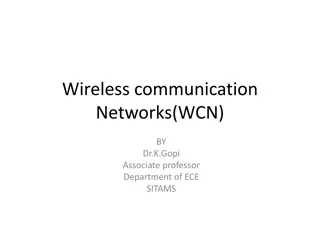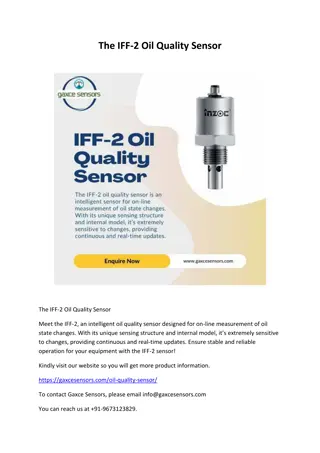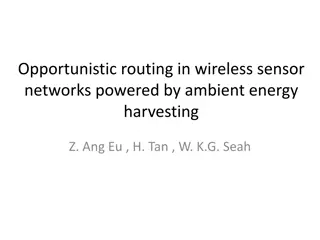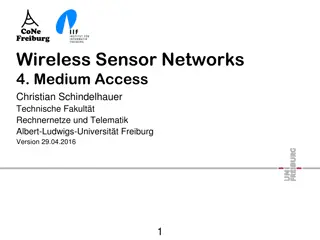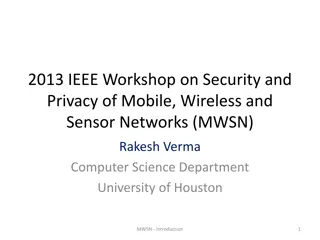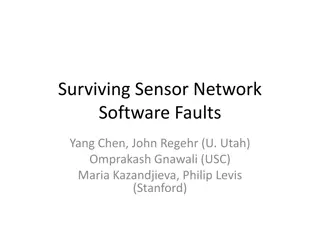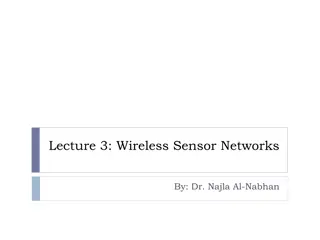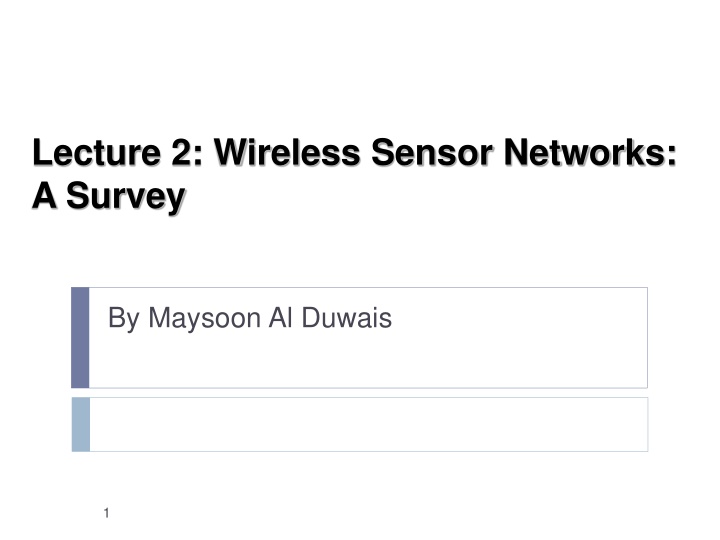
Wireless Sensor Networks: A Comprehensive Overview
This survey explores Wireless Sensor Networks (WSN), including terminologies, components, applications, advantages, disadvantages, and factors influencing design. Understand sensor nodes, communication architecture, protocols, operating systems, and simulators in WSN technology.
Download Presentation

Please find below an Image/Link to download the presentation.
The content on the website is provided AS IS for your information and personal use only. It may not be sold, licensed, or shared on other websites without obtaining consent from the author. If you encounter any issues during the download, it is possible that the publisher has removed the file from their server.
You are allowed to download the files provided on this website for personal or commercial use, subject to the condition that they are used lawfully. All files are the property of their respective owners.
The content on the website is provided AS IS for your information and personal use only. It may not be sold, licensed, or shared on other websites without obtaining consent from the author.
E N D
Presentation Transcript
Lecture 2: Wireless Sensor Networks: A Survey By Maysoon Al Duwais 1
Outline Terminologies What is WSN? WSN Components Sensor Node Functions Type Example Wireless Sensor Networks Applications WSN Characteristics WSN Advantages & disadvantages Factors Influencing Sensor Network Design Sensor Networks Communication Architecture Sensor Network Protocols Sensor Networks Operating Systems Sensor Networks Simulators Conclusion 2
Terminologies sensor A transducer converts physical phenomenon e.g. heat, light, motion, vibration, and sound into electrical signals sensor node basic unit in sensor network contains on-board sensors, processor, memory, transceiver, and power supply sensor network consists of a large number of sensor nodes nodes deployed either inside or very close to the sensed phenomenon 3
What is WSN? A wireless sensor network (WSN) is a wireless network that consists of distributed sensor nodes that monitor specific physical or environmental events or phenomena, such as temperature, sound, vibration, pressure, or motion, at different locations. The first development of WSN was first motivated by military purposes in order to do battlefield surveillance. Nowadays, new technologies have reduced the size, cost and power of these sensor nodes besides the development of wireless interfaces making the WSN one of the hottest topics of wireless communication. 4
WSN Components There are four basic components in any WSN: (1) a group of distributed sensor nodes. (2) an interconnecting wireless network (3) a gathering-information base station(Sink) (4) a set of computing devices at the base station (or beyond) to interpret and analyze the received data from the nodes Note: sometimes the computing is done through the network itself 5
Sensor Node Sensor nodes, Low-cost and low-power devices used to accumulate the desired data and forward it to the base station. A sensor node is composed of: Sensing unit Radio transceiver or other wireless communications device Microcontroller / Processing Unit. Energy source, usually a battery, some sensor nodes have an additional memory component Location Finding System (optional) Power Generator (optional) Mobilizer (optional) 1. 2. 3. 4. 5. 6. 7. 8. 7
Sensor Node Functions Functionality of sensor nodes lies behind the ability of the node to either being the source of the data (i.e. senses the event) then transmits it. or just being a pure transceiver that receives data from other sources then forwards it to other nodes in order to reach the base station. Functionality depends on the network architecture 9
Sensor Node Types The size of a single sensor node can vary from shoebox- sized nodes to the size of a dust. The cost of sensor nodes is similarly variable, ranging from hundreds of dollars to a few cents, depending on: the size of the sensor network the complexity of individual sensor nodes. 1. 2. The different types of sensors Seismic, thermal, visual, infrared 10
Wireless Sensor Networks Applications Monitoring friendly forces, equipment, and ammunition Battlefield surveillance Reconnaissance of opposing forces and terrain Targeting Battle damage assessment Nuclear, biological, and chemical attack detection 12
Wireless Sensor Networks Applications 1. Forest fire detection 2. Bio-complexity mapping of environment 3. Flood detection 4. Precision Agriculture 5. Air and water pollution 13
Wireless Sensor Networks Applications Health Care Applications Telemonitoring of human physiological data Tracking and monitoring doctors and patients inside a hospital Drug administration in hospitals 14
Wireless Sensor Networks Applications Home and Office Applications Home and office automation Smart environment 15
Wireless Sensor Networks Applications Automotive Applications Reduces wiring effects Measurements in chambers and rotating parts Remote technical inspections Conditions monitoring e.g. at a bearing 16
Wireless Sensor Networks Applications Automotive Applications 17
Wireless Sensor Networks Applications Other Commercial Applications Environmental control in office buildings (estimated energy savings $55 billion per year!) Interactive museums Detecting and monitoring car thefts Managing inventory control Vehicle tracking and detection 18
WSN Characteristics Power consumption constraints for nodes using batteries or energy harvesting Chance to cope with node failures (Fault Tolerance/Recovery) Mobility of nodes Heterogeneity of nodes Scalability to large scale of deployment Capability to cope with harsh environmental conditions Simplicity of use More use of broadcast communications instead of point-to- point Nodes do not have a global ID such as an IP number 1. 2. 3. 4. 5. 6. 7. 8. 9. 19
WSN Advantages Network setups can be carried out without fixed infrastructure. 1. Suitable for the non-reachable places such as over the sea, 2. mountains, rural areas or deep forests. Flexible if there is a random situation when additional workstation 3. is needed. It avoids plenty of wiring. 4. It is scalable, might accommodate new devices at any time. 5. It can be accessed by using a centralized monitor. 6. 20
WSN Disadvantages Less secure because hackers can enter the access point and obtain 1. all the information. Lower speed compared to wired networks. 2. More complicated to configure compared to a wired network. 3. Easily troubled by surroundings (walls, microwave, large distances 4. due to signal attenuation, etc). It is easy for hackers to hack it we couldn t control propagation of 5. waves. Comparatively low speed of communication. 6. Still Costly (most importantly). 7. 21
Factors Influencing WSN Design Fault tolerance Scalability Production costs Hardware constraints Sensor network topology Environment Transmission media Power Consumption Sensing Communication Data processing 22
WSN Operations Two important operations in a sensor networks Data dissemination : the propagation of data/queries throughout the network Data gathering : the collection of observed data from the individual sensor nodes to a sink 23
Data Dissemination Data dissemination: is the process by which queries or data are routed in the sensor network. The data collected by sensor nodes has to be communicated to the node which is interested in the data. The node that generates data is called source. the information to be reported is called an event. A node which interested in an event is called sink. Data dissemination consist of a two-step process: interest propagation and data propagation. a. Interest propagation: for every event that a sink is interested in, it broadcasts its interest to is neighbor, and across the network. b. Data dissemination: When an event is detected, it is reported to the interested nodes (sink). 24
Flooding Each node which receives a packet (queries/data) broadcasts it until the packet reaches the destination node. Disadvantages : Implosion : Happens when duplicate messages sent to the same node. Occurs when a node receives copies of the same messages from many of its neighbors. Overlap : the same event may be sensed by more than one node due to overlapping regions of coverage. This results in their neighbors receiving duplicate reports of the same event. Resource blindness : the flooding protocol does not consider the available energy at the nodes and results in many redundant transmissions. Hence, it reduces the network lifetime. 25
Gossiping Modified version of flooding The nodes do not broadcast a packet, but send it to a randomly selected neighbor. Avoid the problem of implosion It takes a long time for message to propagate throughout the network. It does not guarantee that all nodes of network will receive the message. 26
Data Gathering The objective of the data gathering problem is to transmit the sensed data from each sensor node to a BS. The goal of algorithm which implement data gathering is maximize the lifetime of network Minimum energy should be consumed The transmission occur with minimum delay 27
Sensor Network Architecture The two basic kinds of sensor network architecture Layered Architecture Clustered Architecture 28
Layered Architecture A layered architecture has a single powerful base station (BS), and the layers of sensor nodes around it corresponds to the nodes that have the same distance to the BS. The BS acts an access point to a wired network, and small nodes form a wireless backbone to provide wireless connectivity. The advantage of a layered architecture is that each node is involved only in short-distance, low-power transmissions to nodes of the neighboring layers. 29
Unified Network Protocol Framework (UNPF) UNPF is a set of protocols for complete implementation of a layered architecture for sensor networks UNPF integrates three operations in its protocol structure: Network initialization and maintenance MAC protocol Routing protocol 31
Clustered Architecture A clustered architecture organizes the sensor nodes into clusters, each governed by a cluster-head. The nodes in each cluster are involved in message exchanges with their cluster-heads, and these heads send message to a BS. Clustered architecture is useful for sensor networks because of its inherent suitability for data fusion. The data gathered by all member of the cluster can be fused at the cluster-head, and only the resulting information needs to be communicated to the BS. The cluster formation and election of cluster-heads must be an autonomous, distributed process. 32
Low-Energy Adaptive Clustering Hierarchy (LEACH) LEACH is a clustering-based protocol that minimizes energy waste in sensor networks. The operation of LEACH is spilt into two phases : setup and steady. Setup phase: Cluster heads are selected. The cluster-heads advertise their selection to all nodes. All nodes choose their nearest cluster-head by signal strength. The cluster-heads then assign aschedule for their cluster members. Steady phase: Data transmission takes place based on the schedule. The cluster-heads perform data aggregation/fusion. After a certain period of time in the steady phase, cluster-heads are selected again through the setup phase. 34
WSN Operating Systems TinyOS Contiki MANTIS BTnut SOS Nano-RK 36
TinyOS Event-driven programming model instead of multithreading TinyOS and its programs written in nesC Main (includes Scheduler) Application (User Components) Communication Actuating Sensing Communication Hardware Abstractions 37
TinyOS Charactersitics Small memory footprint non-preemptable FIFO task scheduling Power Efficient Puts microcontroller to sleep Puts radio to sleep Concurrency-Intensive Operations Event-driven architecture Efficient Interrupts and event handling No Real-time guarantees 38
WSN Simulators NS-2 GloMoSim OPNET SensorSim J-Sim OMNeT++ Sidh SENS 39
WSN Emulators TOSSIM ATEMU Avrora EmStar 40
References I. F. Akyildiz, W. Su, Y. Sankarasubramaniam, and E. Cayirci, Wireless Sensor Networks: A Survey , Elsevier Computer Networks, volume 38, Issue 4, pp. 393- 422, March 2002. Dr. Victor Leung, Lecture Slides on Wireless Sensor Networks , University of British Columbia, Canada D. Curren, A Survey of Simulation in Sensor Networks Wikipedia, [Available Online] http://en.wikipedia.org/wiki/Wireless_Sensor_Networks Fahad Al-Jabarti & Khaled Al-Omar A Survey on Wireless Sensor Networks (WSN) Arslan Munir Wireless Sensor Networks: A Survey , University of Florida Dr. Chenyang Lu Slides on Berkeley Motes and TinyOS , Washington University in St. Louis, USA J. Hill and D. Culler, A Wireless Embedded Sensor Architecture for System- Level Optimization , Technical Report, U.C. Berkeley, 2001. X. Su, B.S. Prabhu, and R. Gadh, RFID based General Wireless Sensor Interface , Technical Report, UCLA, 2003. 41

